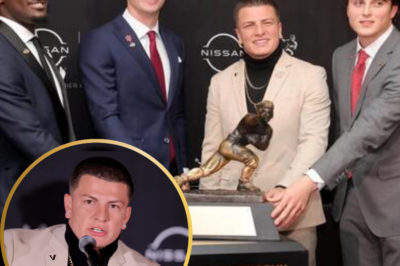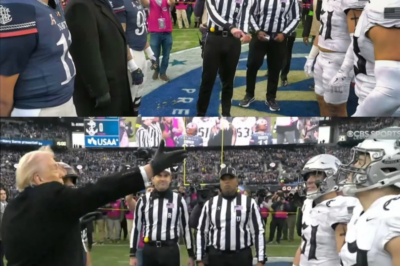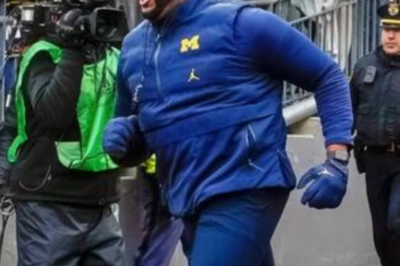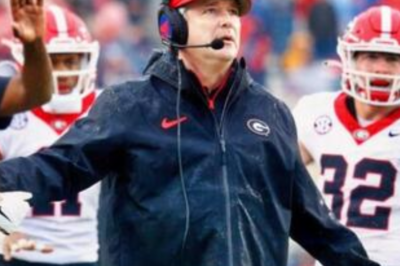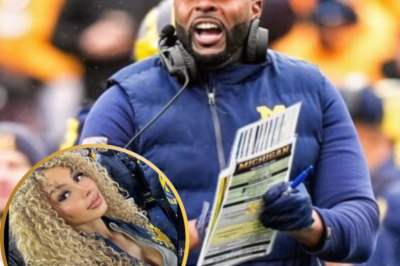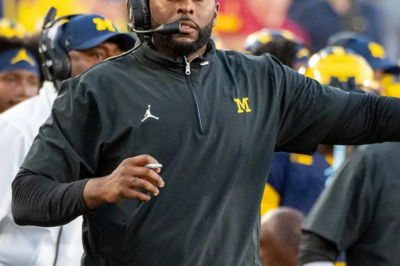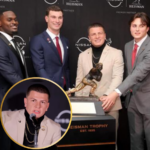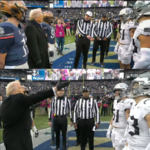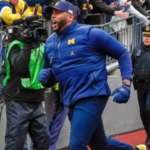Did Ryan Clark just make the most DISRESPECTFUL move in NFL history?! Fans are FURIOUS after spotting what he wore on ‘MNF’—you won’t BELIEVE your eyes.
In the high-stakes, meticulously choreographed universe of professional sports broadcasting, where every word is analyzed and every graphic is focus-grouped, it is a rare occurrence for a piece of non-verbal communication to detonate a cultural landmine.
Yet, that is precisely what transpired on a recent edition of ESPN’s flagship program, Monday Night Football, when veteran analyst and former NFL safety Ryan Clark took his seat at the desk.
Unbeknownst to him at that moment, a small, seemingly innocuous accessory pinned to his lapel was about to become the centerpiece of a sprawling digital controversy, overshadowing the on-field action and triggering a torrent of rage, confusion, and fervent debate across the National Football League’s vast and passionate fanbase.
This is not merely the story of a fashion choice; it is a case study in modern media consumption, the power of symbolism, and the volatile, instantaneous nature of fan reaction in the age of social media.
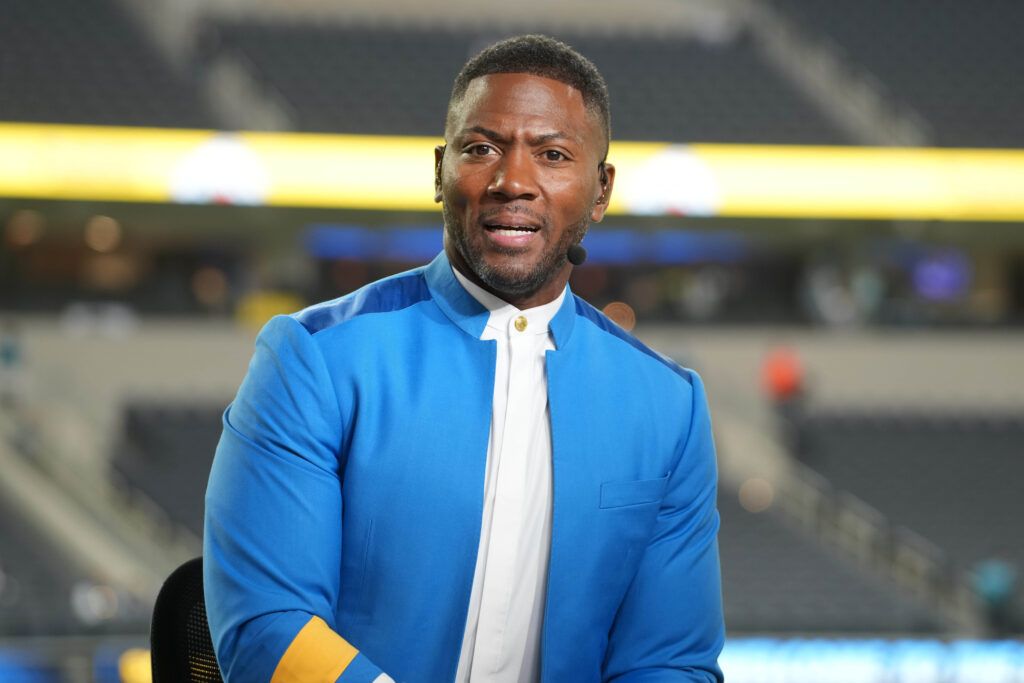
The incident, which unfolded during the pre-game show or a halftime segment—the exact timing itself becoming a point of scrutiny—was initially missed by the casual viewer.
The cameras panned across the analyst desk, where Clark, alongside colleagues like Robert Griffin III and host Scott Van Pelt, was dissecting the upcoming matchup.
For a majority of the audience, the focus was on the insightful commentary and the game preview. However, in an era defined by hyper-vigilance and the ability to screenshot, zoom, and enhance, no detail remains hidden for long.
It was only a matter of minutes before a segment of the viewership, their attention perhaps caught by a glint of light or an unusual shape, zeroed in on Clark’s attire.
There, prominently displayed on his lapel, was a brooch. The specific design of this piece of jewelry is the very crux of the controversy.
Descriptions from viewers varied, but a consensus began to emerge on social media platforms, primarily X (formerly Twitter), Instagram, and dedicated sports forums like Reddit’s r/NFL. Some users asserted the brooch featured an abstract, sharp, almost weapon-like design.
Others claimed it bore a resemblance to a corporate logo unfamiliar to the sports world.
A smaller subset speculated about potential political or social symbolism, though no definitive evidence for such claims was immediately presented.
What is critical to understand is that the ambiguity of the brooch’s meaning became a vacuum, and into that vacuum rushed the interpretations, assumptions, and, most powerfully, the anger of millions of fans.
The eruption was swift and volcanic. The hashtag #RyanClark began trending on X within the hour, not for his analytical prowess, but for the accessory he chose to wear.
The timeline transformed into a digital town square of outrage. “Is Ryan Clark trying to send a message?” one popular tweet read, amassing tens of thousands of likes and retweets.
“What is that brooch? This is so disrespectful to the game and to the teams playing tonight.” Another user posted a meticulously zoomed-in and enhanced photograph of the brooch, their caption demanding an immediate explanation from ESPN and Clark himself.
The comments section beneath this post became a war zone, with factions forming in real-time.
The criticism was multifaceted. A significant portion of the anger stemmed from a sense of perceived disrespect. For these fans, the broadcast booth of Monday Night Football is a hallowed ground, a place for pure football analysis. The introduction of any element that could be construed as a personal, political, or otherwise “outside” statement was seen as a violation of that space.
“I tune in to watch football, not a fashion show or a political rally,” a common sentiment echoed across hundreds of comments. “Keep your controversial jewelry at home.”
This perspective highlights a deep-seated desire among a segment of sports fans to view athletics as an escape from the divisive issues of the day, a sanctuary where the only thing that matters is the performance on the gridiron.
Another layer of the fury was rooted in tribalism. The teams playing that night found their fan bases uniting in a shared sense of insult.
Supporters of both sides began to speculate whether the brooch was a subtle dig at their specific franchise, a player, or a city.
Without a clear explanation, the void was filled with paranoid theories. “He’s always been biased against our team,” one fan wrote, “and now he’s wearing that thing to mock us.
It’s disgusting.” This phenomenon demonstrates how the analyst, once a neutral observer, becomes a canvas onto which fan bases project their insecurities and rivalries.
Clark’s brooch, regardless of its intent, was instantly weaponized in the endless online battles between NFL fandoms.
Furthermore, the controversy tapped into a broader, ongoing cultural conversation about the role and responsibilities of sports media personalities.
In today’s landscape, figures like Stephen A. Smith, Shannon Sharpe, and Pat McAfee have built empires on strong, often controversial, opinions.
They are personalities as much as they are analysts. For some viewers, Ryan Clark’s brooch was an extension of this trend—a non-verbal form of provocation designed to generate clicks and engagement, a tactic sometimes dismissed as “clickbait” in real life.
Critics accused him of seeking attention at the expense of the game itself, of creating a “distraction” from the athletes whose efforts should be the sole focus.
As the digital firestorm intensified, the response from Ryan Clark and ESPN became the next critical point of observation.
The network, a behemoth in the sports media industry, is known for its meticulous management of its public image and its talent.
The initial silence from both parties only served to fuel the speculation. Was the brooch a sanctioned part of the broadcast?
Was it a personal statement that had slipped through the network’s standards and practices? Or was it, as some began to quietly suggest, a complete nothingburger—a simple piece of jewelry with no deeper meaning, tragically misconstrued by an online mob?
Clark, an individual known for his thoughtful and often emotionally resonant commentary, eventually addressed the controversy.
His response, when it came, was closely scrutinized. Did he issue a public apology on his social media channels, expressing regret for the unintended distraction?
Or did he offer a defiant explanation, clarifying the brooch’s origin and meaning, and perhaps even pushing back against the critics?
Perhaps he took a more nuanced approach, using the incident as a teachable moment to discuss the perils of assumption and the speed of judgment in the digital age.
The specific nature of his response would fundamentally shape the narrative’s second chapter, either quelling the outrage or pouring gasoline on the flames.
The implications of this single event extend far beyond one man’s choice of accessory.
This incident serves as a powerful lens through which to examine several key aspects of contemporary sports media and fan culture:
The Magnifying Glass of High-Definition Broadcasting:
In an age of 4K resolution and constant screen-capturing, every detail on a live broadcast is subject to microscopic examination. There is no such thing as an insignificant detail anymore. A tie clip, a wristband, a facial expression, or a piece of jewelry can be isolated, magnified, and disseminated to millions in seconds, stripped of all context.
The Economy of Outrage:
Social media platforms are engineered to reward engagement, and nothing generates engagement quite like moral outrage and tribal conflict. The Ryan Clark brooch incident is a prime example of how a spark can be fanned into a wildfire by algorithms that prioritize divisive and emotionally charged content. The economic incentive for users to post the most incendiary take drives the cycle forward.
The Evolving Role of the Analyst:
The days of the stoic, emotionless sportscaster are fading. Today’s successful analysts are encouraged to be personalities, to have a brand, and to connect with audiences on a personal level. This, however, creates a tightrope walk. Any personal expression—whether sartorial, verbal, or otherwise—risks being interpreted as a professional transgression by a segment of the audience that prefers a sterile, football-only environment.
Symbolic Ambiguity in a Polarized Climate:
Click on ‘Follow Us’ and get notified of the most viral NFL stories via Google!Follow Us
“Why is Ryan Clark wearing a clash Royale woman’s brooch,” a user asked.
“It’s such a silly thing to see,” inquired another.
“Ryan Clark sporting an even cornier “RC” lapel than I thought was possible,” a fan added.
“There is no way to avoid Ryan Clark’s custom brooch every Monday night. Sends me into fight or flight,” said another.
In a culturally and politically polarized society, ordinary objects can become charged with unintended meaning. A brooch that might have passed without comment a decade ago can now be instantly analyzed, decoded, and assigned a controversial identity by a public predisposed to looking for hidden agendas.
In conclusion, the eruption of rage following Ryan Clark’s brooch choice on Monday Night Football is a story that transcends sports.
It is a definitive narrative of our times, illustrating the complex interplay between media, celebrity, and a digitally empowered fanbase.
It forces us to question where the line should be drawn between personal expression and professional presentation, and it highlights the immense power of viral interpretation.
While the final score of the football game played that night will be recorded in a record book, the story of the brooch will be remembered as a poignant moment that revealed the intense, often unforgiving, spotlight under which modern sports figures operate.
It is a stark reminder that in today’s media ecosystem, the analyst is not just heard; they are seen, scrutinized, and sometimes, condemned, for every single choice they make, no matter how small it may seem. The conversation about this event will likely continue to simmer, a testament to the enduring power of a single symbol in the collective imagination of millions.
News
SHOCKING LIE UNCOVERED: Diego Pavia’s deception isn’t just a scandal—it’s a revelation that threatens to EXPOSE the entire 2025 Heisman race as a fraud. What are they hiding?
SHOCKING LIE UNCOVERED: Diego Pavia’s deception isn’t just a scandal—it’s a revelation that threatens to EXPOSE the entire 2025 Heisman race as…
VIDEO: Trump’s single coin flip changes EVERYTHING. What happened next will leave you speechless.
VIDEO: Trump’s single coin flip changes EVERYTHING. What happened next will leave you speechless. In the annals of American political…
SHOCK MOVE: Sherrone Moore Just DROPPED A BOMB on Social Media… And It’s About to IGNITE The Rivalry.
SHOCK MOVE: Sherrone Moore Just DROPPED A BOMB on Social Media… And It’s About to IGNITE The Rivalry. In the…
BREAKING: 2 Georgia Stars Arrested in Shocking Pre-Playoff Incident—Will It Derail Their Championship Run?
BREAKING: 2 Georgia Stars Arrested in Shocking Pre-Playoff Incident—Will It Derail Their Championship Run? In a shocking turn of events…
SHOCKING: Film Star Claims This Photo Shows Sherrone Moore’s SECRET During Michigan’s Biggest Game. You Won’t BELIEVE What He Was Really Doing.
SHOCKING: Film Star Claims This Photo Shows Sherrone Moore’s SECRET During Michigan’s Biggest Game. You Won’t BELIEVE What He Was…
SHOCKING: Michigan makes urgent employment decision involving Sherrone Moore’s personal life. You won’t BELIEVE the details.
SHOCKING: Michigan makes urgent employment decision involving Sherrone Moore’s personal life. You won’t BELIEVE the details. In the world of college…
End of content
No more pages to load

![NFL Fans Erupt in Rage After Spotting ESPN's Ryan Clark's Controversial Brooch Choice During 'MNF' [PHOTOS] - NewsBreak](https://img.particlenews.com/image.php?type=thumbnail_580x000&url=1Q8Tt8_15sMEDHP00)
![NFL Fans Erupt in Rage After Spotting ESPN's Ryan Clark's Controversial Brooch Choice During 'MNF' [PHOTOS] - NewsBreak](https://img.particlenews.com/image.php?type=thumbnail_580x000&url=1bg0hB_15sMEDHP00)
